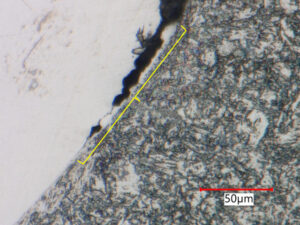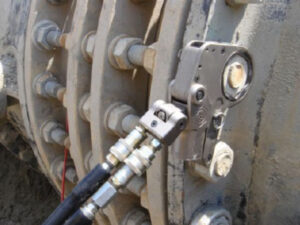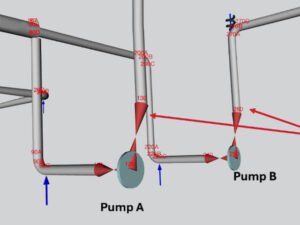Foundation settlement poses a significant threat to the integrity of aboveground storage tanks (ASTs). Correcting excessive settlement typically requires major repairs including re-leveling the foundation and replacing components that have experienced excessive plastic strain. Re-leveling of a sizable tank is expensive and has certain risks associated with the procedure; thus, deciding to re-level an AST is crucial and relies on the proper interpretation and evaluation of the monitored settlement data.
ASTs are inherently flexible structures, so significant foundation settlement can often be tolerated. Settlement evaluation methods are provided in API 653 Tank Inspection, Repair, Alteration, and Reconstruction1 (API 653) to evaluate an AST’s suitability for service. Alternatively, API 579-1/ASME FFS-1 Fitness-For-Service (API 579) can be referenced to supplement the API 653 guidance and provides a more rigorous means to evaluate the fitness for service (FFS) of an AST undergoing settlement. This article will take a detailed look at the most commonly used API 653 evaluation methods to provide insight into the limitations and use of the various techniques and show the potential benefit of detailed analysis.
A wide variety of foundation designs exist to accommodate different surface, subsurface, and climatic conditions where ASTs are installed. Settlement damage is most commonly associated with compacted soil or ringwall foundations and with ASTs of larger sizes (e.g., diameter > 50 ft). In these designs, the thickness, elasticity, and compressibility of the foundation and soil layers can vary enough to produce nonplanar distortions with the application of uniform loading. Furthermore, non-uniform loading, such as snow loads transferred from the roof, can contribute to excessive differential settlement. Soil quality, environmental factors such as frost lines and rainfall, and tank service also contribute to an AST’s likelihood to experience settlement.
Settlement can manifest in a variety of ways, or modes, due to the significant number of contributing factors. Settlement can be local, where only an isolated area of the tank bottom experiences displacements, or global, where the entire bottom is affected, which often affects the shell and other tank appurtenances as well. Uniform settlement and rigid body tilt do not exhibit a major cause for concern if appropriate flexibility is afforded in tank attachments (e.g., piping) and serviceability limits are maintained (e.g., floating roof travel). Non-uniform settlement modes that develop near the critical shell-to-corner joint are often of most concern; two such settlement modes are differential shell settlement and bottom edge settlement.
Differential Shell Settlement
Differential shell settlement is characterized as variable settlement around the circumference of the tank shell. When characterizing differential settlement, it is important to first remove any uniform and/or rigid body tilt components from the raw data set to get an accurate understanding of the out-of-plane measurements (Figure 1). Typical consequences of excessive differential settlement are shell distortions that may either contribute to shell buckling/collapse or other serviceability issues related to floating roofs. Several screening assessment methods are available in API 653 for the evaluation of differential settlement. The default method in B.3.2.1 is based on work by Marr2 and anchored in Euler Bernoulli beam theory. This method involves fitting a cosine function to the measured settlement data to represent a rigid plane of tilt and determining the maximum deviation from this plane. This method is found to be highly sensitive to measurement spacing and requires the R2 regression coefficient to be at least 0.9, which is difficult to achieve given the noise inherent to measured settlement data. The second method provided in API 653 B.3.2.2 was developed by E²G’s Andreani and Carr3 through an industry project for API. This method is based on parametric study of over 3700 finite element analysis (FEA) runs performed for a variety of tank designs and sizes using an acceptability criterion of 3% plastic strain and out-of-roundness limits. This method involves defining settlement arcs (spans between minimum settlement readings) with acceptable differential settlement calculated as a function of arc length. This method removes the dependence on settlement measurement spacing and is applicable to settlement profiles that do not follow a rigid tilt plane (i.e., fail the cosine fit regression requirement). Moreover, the method derived from the parametric FEA study captures the complex response of flexible ASTs considering the breadth of in-service AST designs in a manner that the simplified closed-form approach cannot; therefore, the FEA-derived method offers improved accuracy and permits deliberate reductions in conservatism when evaluating tank settlement.

If differential settlement exceeds the acceptability criteria in either of the aforementioned screening methods, then Level 3 FFS procedures per API 579 may be leveraged to provide a detailed and accurate assessment of the damage. Level 3 stress analysis should also be substituted in scenarios where the API 653 Annex B assessments do not properly characterize or relate to the observed damage. For instance, settlement damage near flush clean-out nozzles or differential settlement that exhibits twisting patterns would require detailed Level 3 methods per API 579 to qualify FFS because the screening methods in Annex B of API 653 do not consider these complex stress states. Since differential settlement often contributes to shell distortions that exceed out-of-roundness and plumbness tolerances in API 653, the scope of the Level 3 FFS assessment will typically include a focus on the assessment of the resulting distortions on the AST shell to qualify adequate resistance to buckling, plastic collapse, and associated cracking damage.
Bottom Edge Settlement
Bottom edge settlement occurs when the tank shell settles sharply around the periphery. This type of settlement is often a result of increased loading (e.g., snow) and/or lack of extension or erosion of the foundation shoulder outside of the tank (Figure 2). Edge settlement can impose elevated secondary stresses at the corner joint and nearby bottom welds which, in turn, causes concern for plastic strain and cracking damage. Edge settlement also presents some additional challenges from an inspection standpoint, as internal access to the tank is required to accurately measure the settlement displacements. These measurements taken across the radius of the settled area ‘R’ must be detailed enough to capture the settlement profile (i.e., gradual, or steep drop-off). The original bottom design slope, ‘cone-up’ or ‘cone-down,’ must also be subtracted from the raw data to quantify the settlement displacement magnitude ‘B.’

API 653 Annex B provides a screening method to assess the significance of edge settlement. The original criterion was B=0.37R based upon the theory of large deflection. Through work with API and members of E²G, parametric FEA simulations of tank bottoms were used to supplement empirical data to develop the current allowable settlement curves. This effort removed inherent conservatism from the screening method as shown in Figure 3. Two sets of allowable edge settlement curves are now available to account for the orientation and type of neighboring bottom welds, with an equation to adjust for intermediate orientations (between parallel and perpendicular).

Similar to differential settlement, API 579 Level 3 FFS evaluation can be pursued for cases of edge settlement that either exceed the API 653 Annex B limits or do not conform to the applicability of the published screening methods. Industry data on failures from edge settlement is very scarce; rather, tanks have often been shown to be able to tolerate significant settlement without leaks or failure. Thus, a Level 3 FFS assessment can often be a successful option for continued service as long as proper measures are taken to guard against settlement progression. The Level 3 FFS evaluation uses FEA to quantify stress and strain accumulation in the bottom and corner joint as a result of the measured settlement (Figure 4). Assessment results are sensitive to the settled profile and not just the maximum displacement ‘B’; thus, accurate characterization of the settlement with appropriate spacing ‘R’ is required to support a Level 3 evaluation.

Mitigation
Settlement occurs in soils subjected to sustained vertical pressures, particularly saturated clay strata where liquid can drain out of the soil as the solids are compressed. A geotechnical survey and settlement assessment should be considered for any new tank sites, and improvement techniques such as surcharge loading to accelerate consolidation prior to equipment installation can be carried out to minimize the risk of damage to the installed AST(s). Engineered sand or gravel layers are often employed to minimize settlement near the surface and provide adequate bearing capacity. Deep foundation systems such as piles or drilled caissons can reduce settlement relative to a typical mat or ringwall-type foundation, although these systems are considerably more costly to construct.
When settlement of an in-service AST reaches or exceeds acceptable limits, re-leveling and repair are required if FFS analysis is not otherwise performed. Re-leveling is frequently done by lifting the tank with hydraulic jacks or air bags placed around its periphery at equal distances. Tank lifts are a very important technique for making repairs or modifications to tank foundations and bottoms; however, these operations do come with inherent risks and must be properly engineered for safety. Analysis should be performed to determine an appropriate number of lifting points, and lateral loads due to wind and/or seismic hazards should be considered.
Conclusions
Excess settlement adversely affects the structural and operational reliability of ASTs. An understanding of the various modes and tolerable magnitudes of settlement is crucial to making informed decisions on the need for FFS assessment or repair. Given E²G’s history in developing many of the code-published means of assessing AST settlement, we are intimately familiar with the risks involved with either leaving settlement unaddressed or performing extensive repairs. As such, we are dedicated to leveraging appropriate analysis techniques to optimize outcomes for our clients. Please contact the authors regarding any AST settlement issues or questions by submitting the form below– we are here to help!
- API Standard 653, 5th Ed., Nov. 2014, Addendum 2, May 2020.
- W. A. Marr, J. A. Ramos, and T. W. Lambe, “Criteria for Settlement of Tanks,” Journal of Geotechnical Engineering, 108(GT8), August 1982.
- Andreani, J.L. and Carr, N.A., Study of Out-of-Plane Tank Settlement, API, Washington, D.C., May 2007.
- EEMUA (Engineering Equipment and Materials Users Association), Publication 159, Edition 5, London, 2017.





